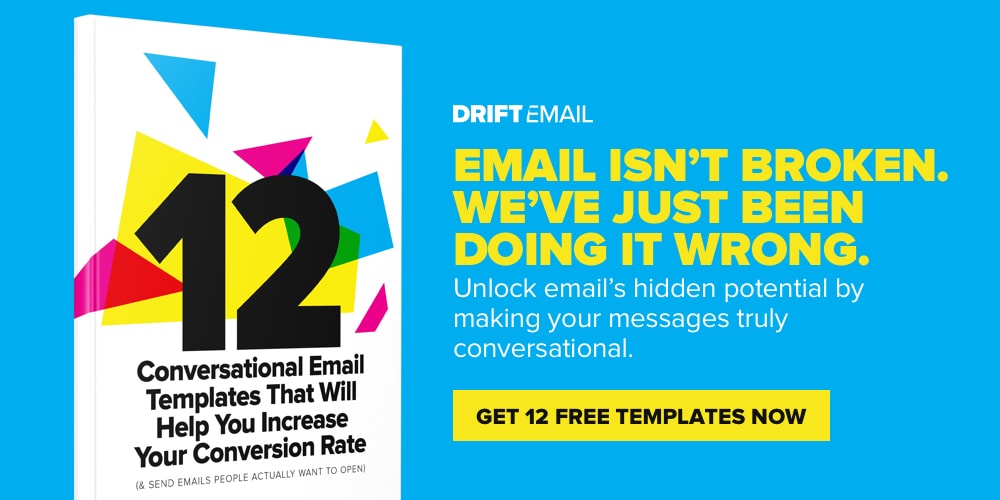Hands up if you spend all day every day thinking about email?
🙋♀️I know I do.
There are so many moving parts to consider: planning integrated campaigns, writing compelling email copy, ABM, A/B testing, setting up the email flow, coding the email itself…
But one thing that can boost your email marketing efforts? Re-engagement programs. They’re such an underappreciated and underutilized way of sparking a conversation with some of your best leads.
But before you can launch a successful re-engagement campaign, you have to address the five W’s: who, what, when, where, and why (I’ll throw in “how” for free).
We all know the where…email. And to help you fill in the remaining four ‘W’s’ I sat down with Evan Doyle, Demand Generation Manager at PathFactory. So let’s deep dive into the tips, tricks, and secrets to get your re-engagement engine off the ground.
Why Build a Re-Engagement Program?
W #1: Why.
Why do we need to re-engage our leads and prospects?
Well, for starters, the average sales cycle length for a B2B business is 102 days.
And as much as I’d like every single email I write to be opened, read, and engaged with, that’s just wishful thinking. It takes six to eight touches just to generate a viable sales lead, and it’s going to take a lot more than eight emails to achieve that.
Email re-engagement programs help you spark conversations with your best leads.
You’ve worked hard to build out your email list. A percentage of those people are your ideal customers – so rather than constantly trying to get new people into your database, why not engage the ones you already have?
You don’t have to reinvent the wheel. You need to re-engage it.
5 W’s to Successful Re-Engagement Programs
Okay, we’ve covered where (email) and why (to have conversations with your best leads), so let’s turn to the rest of the W’s:
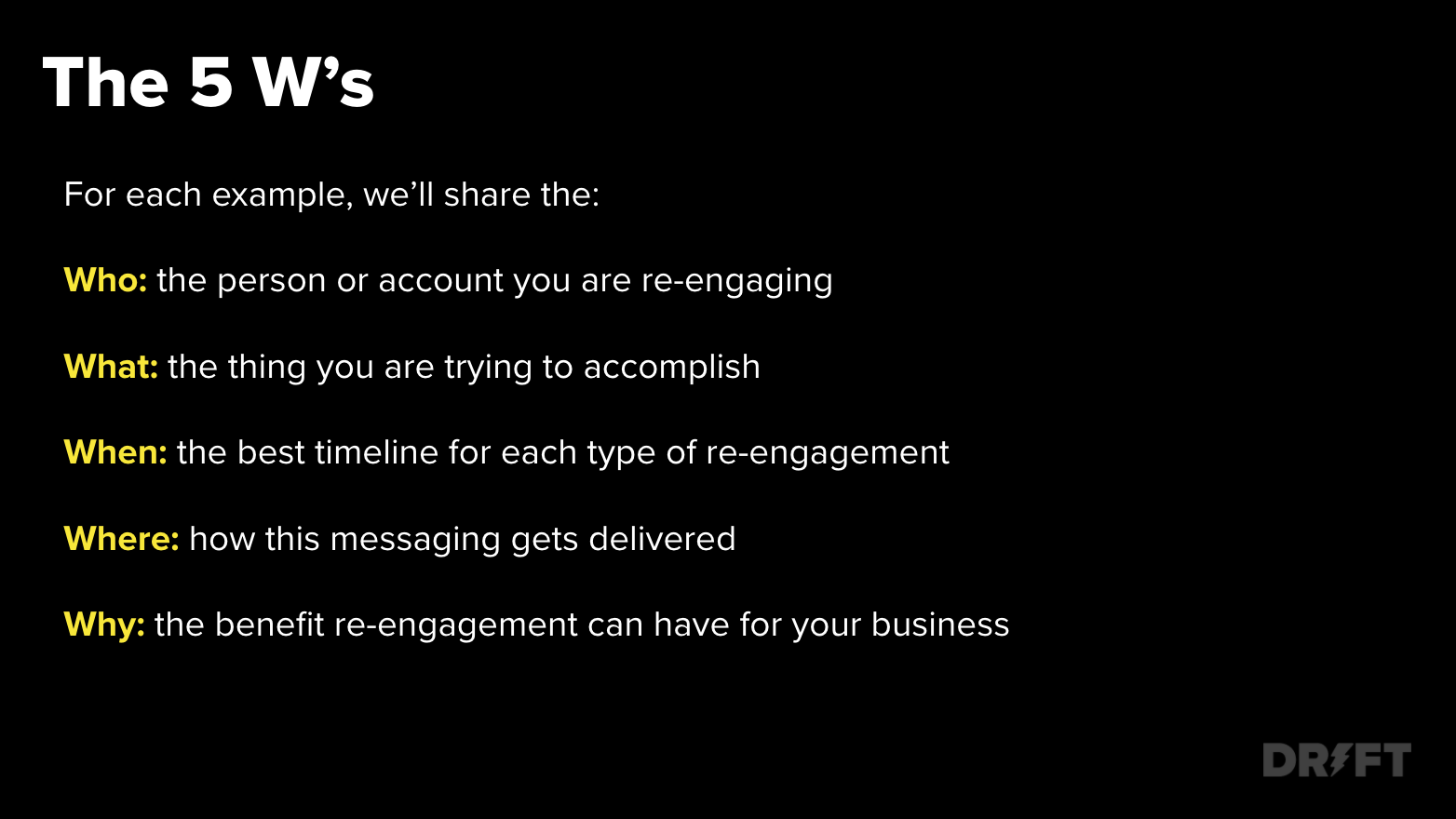
Every re-engagement campaign should answer:
- Who: The person or account you want to re-engage
- What: the thing you’re trying to accomplish (aka your CTA)
- When: the best timeline to re-engage them
- Where: how this messaging gets delivered, tactically
- Why: what benefits re-engagement can have for your business
Like any email campaign, re-engagement campaigns should have a specific goal in mind.
Now it’s time to apply those five W’s to your re-engagement campaigns. Or, you can just steal these four plays that we love 👇
1. When They Showed Some Interest, but Now…
…crickets.
Who: we’re talking about the leads that have gone dark.
When: Send this email somewhere between 90-120 days from the last time they engaged with you. (Just don’t forget to update and refresh that content.)
Where: Make this an automated trigger or nurture program in your marketing automation platform (MAP). Keep in mind to refresh this content on a quarterly basis at a minimum.
What: Here’s a fantastic example of re-engaging those leads from Return Path (now Everest from Validity):

What I love about this is that it puts the customer at the center of the email. Return Path is saying, “Hey, we haven’t seen you in a while. What’s up? How can we help?” They’re not shying away from the fact that their audience isn’t engaging with them.
It’s important that in any re-engagement email you send, you’re adding value to that prospect or lead. So incorporating a few new pieces of content is a great way to ease back into that relationship.
And let’s not forget…
Why: Sending this email creates just enough FOMO to get dormant leads back on a nurture track. Plus, you can ask them to edit their email preferences and help your deliverability, too.
2. When They Just Don’t Really Engage at All…
Did you know digital content engagement increased 40% since the COVID-19 lockdown?
People are actually reading case studies and reports, attending webinars, watching videos, and listening to podcasts. It’s a content marketer’s dream.
And all that digital content you’ve been creating your audience is loving right now? You can leverage it in a re-engagement campaign for your low engagement leads.
Who: These are the people who maybe engage with one piece of content a quarter, but overall have a low behavior score.
When: Send this email after creating a new piece of content, or a new industry or account-based event that can re-start the conversation.
Where: This should come directly from a person, ideally a sales rep for a target account.
What: Take the people who have low engagement, understand what they do care about – say, attending a webinar on a specific topic a few quarters back – and tailoring their re-engagement path based on what they’re interested in. Offer them more of what sparked their interest in the first place.
This is something I send to those low engagement leads:
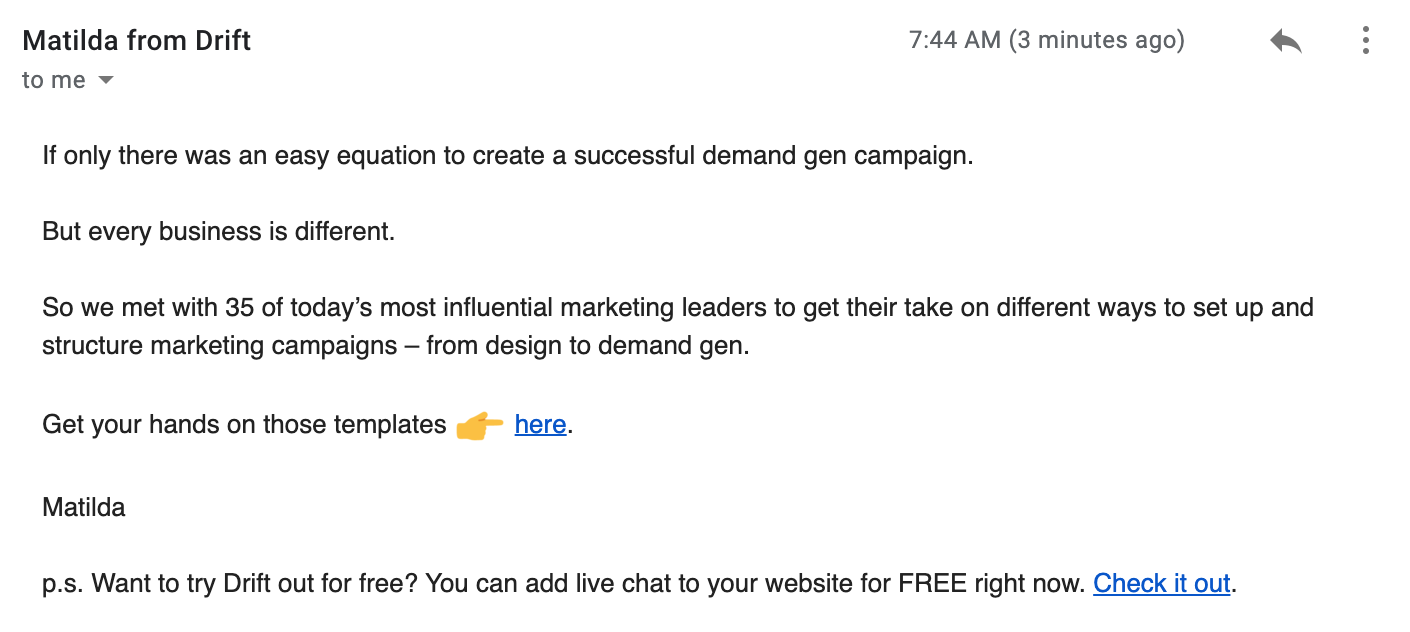
And you can see here, there are actually two CTAs. (Sneaky, sneaky!)
There’s the main CTA, which is around the ebook offer. But I snuck in a little P.S. at the bottom to test drive Drift, allowing them to move faster through the funnel if they want to, or if they’re curious about what we do.
Why: If you want to move these people down the funnel, you’ll need to get them to interact with you. This creates that opportunity, adding value for your prospects and keeping you relevant.
3. When They’re Already Engaging With You, But You Want More…
Ok, I’ll be honest.
I stole this next idea from Netflix. But it’s sooo good, every B2B marketer should try it at least once.
Think about Netflix for a second. They have 3,000+ movies, documentaries, TV shows, and more. Whether you want to get nostalgic and watch Ferris Bueller’s Day Off for the 50th time (oh, to be back in high school), or you want to laugh at Emmy-sweep sitcom Schitt’s Creek, Netflix has everything.
There’s much content that one person could ever watch it all (even though Netflix had a very clever year-end campaign around that very concept).
The same is true for your prospects. They may just be interested in one aspect of your products or looking to brush up on a specific skill set. Either way, it’s unlikely they’ll engage with every single piece of content you’ve ever made.
So here’s what you do:
Who: The prospects that engage with your content – just maybe not on a regular basis.
When: Send this email at least one day after their initial engagement. Unlike an abandoned cart you would send right away, there’s probably a reason they got distracted, so give them a little bit of space.
Where: Automate it through your MAP.
What: If you spent all of January binge-watching the latest craze (or catching up on popular series like Stranger Things), then you’ve probably seen the Netflix email that asks you what you want to watch next:
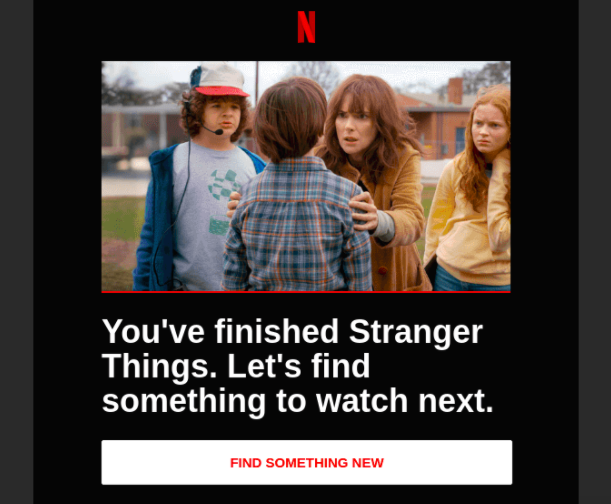
Image source
Well, guess what? We can all learn a thing or two from Netflix. That kind of engagement-based recommendation just makes sense. Of course you’d want to keep watching – if you loved one show, you’ll probably love the next one.
That’s why PathFactory sends this email:

This type of email should recommend something your prospects will like based on browsing behavior or encourage you to dive back into the content they’re already engaging with.
Why: Engagement builds upon engagement.
A re-engaged audience spends 183% more time on an ebook than an audience that isn’t re-engaged.
Send this email to capitalize on engaged prospects while they’re engaged with you to move them faster along the funnel. They’re already interacting with you, so why not take it a step further? If you keep a light touch on the emails and make them natural, relevant, and personalized, you’ll start to build more trust.
It’s the perfect example of talking to the right audience at the right time.
(Bonus: That subject line – “A message from future <firstname>” – has a 50% average open rate. You’re welcome.)
4. When You Lost the Opportunity the First Time Around…
There’s still hope.
Who: We get so busy focusing on throwing new people into the funnel, we can forget the subset of closed-lost accounts that showed strong interest, but for one reason or another, didn’t end up pursuing a deal.
When: Send this email after at least six months (or the standard contract length for your industry). Either way, it should be a significant amount of time from the original deal.
Where: This should come from a sales rep, especially for your target accounts.
What: A little personalization can go a long way with this one.
Why: You never know until you try.
Most CRMs give reps the ability to mark the reason behind a closed-lost opportunity, which gives you as a marketer a few different paths to respond to. There’s a big difference between losing to a competitor, for example, and losing to bad timing.
Email can be the first step to changing their minds or restarting the sales conversation.
That’s why I like to send this email:
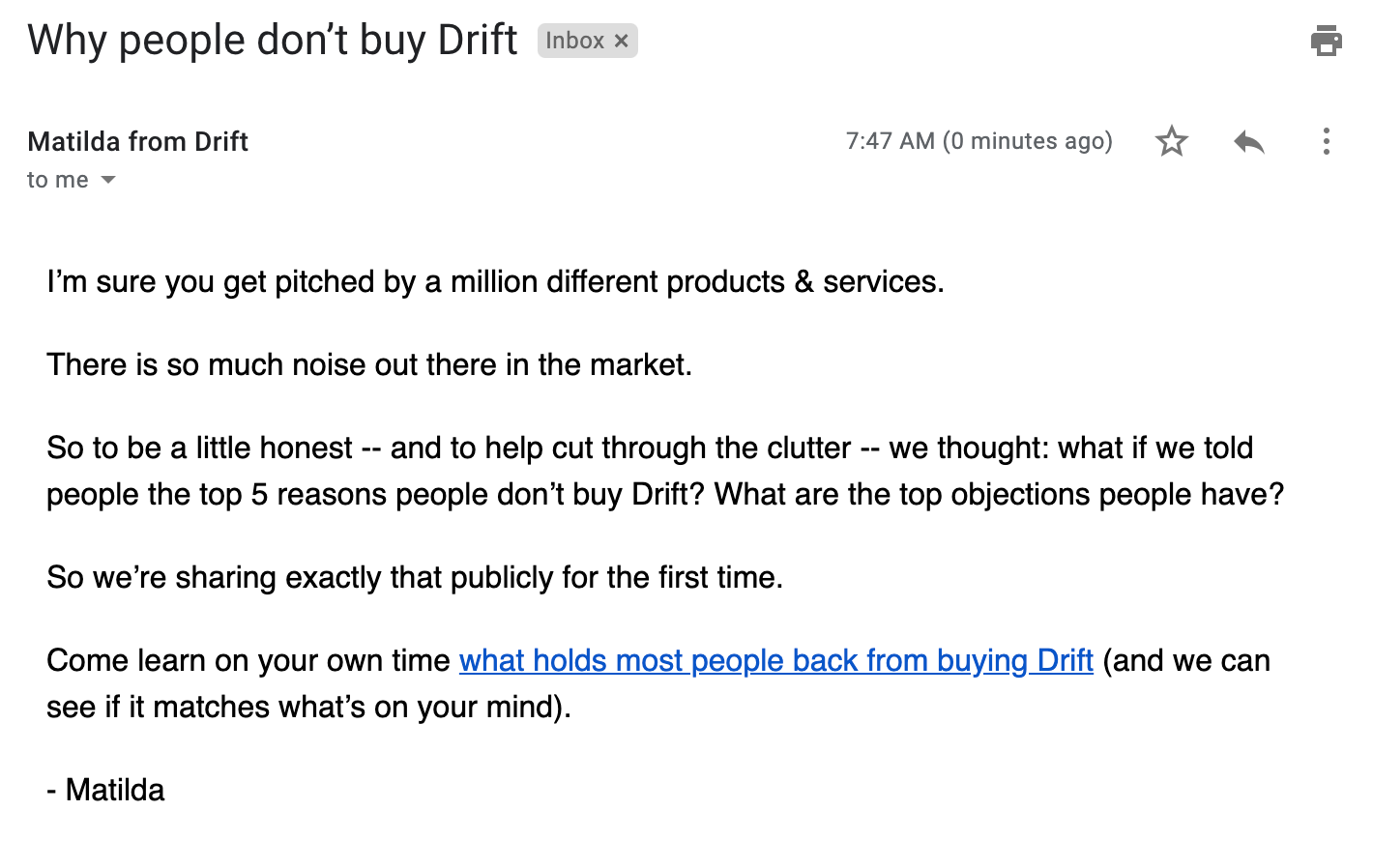
I like to be brutally honest with our emails.
You probably already have objection handling for your sales team. Now it’s time to publish it. People want to know why, and for closed-lost opportunities, whether or not they were alone in their decision.
This one is our best-performing email for closed-lost opportunities, and that’s because we’re not trying to sell. But what this email does is get those people back into our funnel and re-engaging with our marketing campaigns.
Spark More Conversation with Re-Engagement Programs
Re-engagement programs aren’t just for leads you haven’t heard from in a while. They can increase engagement across the funnel.
That’s because they’re about sparking conversations, not necessarily recovering those leads. You can’t hit someone over the head with a sales message in a re-engagement program – you’ll just scare them away.
Instead, add value.
Every email you send to a prospect should add value in some way. And when it comes to re-engagement, that’s especially true.
Build the foundation of a conversation they want to be a part of, whether that’s with exciting new content or something tailored specifically to their interests.
To recap:
- Re-engagement programs are not just for leads that have gone dark, they can improve engagement in many ways. Use re-engagement programs to target:
- Leads that showed some interest that are now dormant
- Leads with low engagement
- Leads that have demonstrated engagement and are ready for nurture
- Closed-lost opportunities
And when all else fails, remember the 5 W’s to create email re-engagement programs to get back in front of your best leads.





